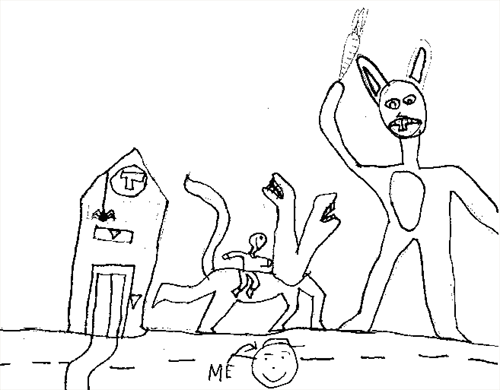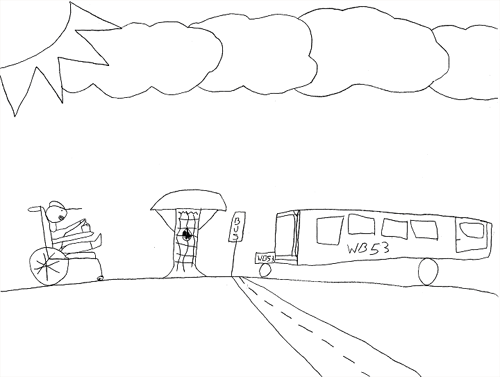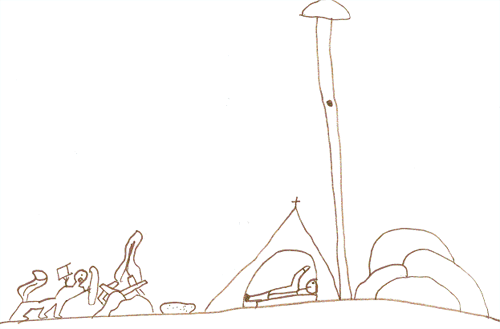

| Homepage • Part 1 • Part 2 • Part 3 • ContactEMAIL |
| copyright |
That’s How I Got Egg on My Head and Other Adventures
Kenneth [last name withheld]
One of the first schools I contacted when I began looking for contributions to this anthology was the Kennedy Day School of the Franciscan Children’s Hospital and Rehabilitation Center in Boston. Kenny, ten years old at the time, was a student there, and a drawing of his was submitted to me to consider including in this collection. The imaginativeness and humor of Kenny’s drawing struck me immediately, and I asked if I might interview the artist. The answer was an enthusiastic yes: it turned out that Kenny was considered the student “spokesperson”; he was not only articulate but enjoyed talking with strangers, and when the press or other visitors wanted to speak with a Kennedy Day School student, Kenny was often chosen to do the honors.
By the time we met, Kenny had turned eleven. He was small for his age because of his disability, osteogenesis imperfecta, and he used an electric wheelchair. His demeanor was self-assured, almost nonchalant, but his eyes sparkled and a mischievous smile played around his lips. So that Kenny could draw pictures during our interview, we brought several sheets of blank paper and a small tin box full of markers with us into our meeting room. Kenny drew as we talked. Three of his drawings, including the one that had first endeared Kenny to me, follow the excerpts from our interview below.
L: Can you explain what it means to have osteogenesis imperfecta?
K: It means that you have to be very careful with me ‘cause I break easy, like a glass. I can’t, like, go on special rides like roller coasters and those kind of things. Like hills or somethin’ like that.
L: What kinds of things are you able to do that you enjoy — besides drawing?
K: I can usually go to the mall. I go a lot with my dad and my mom ‘cause we live right next door to the mall. And we go to the movies. And . . . I go to bed by myself and, let’s see . . . there’s so much stuff I can do.
L: How do you get into bed by yourself?
K: Usually I have a sliding board. I can’t get up into my bed. I can get down in my chair. ‘Cause the bed’s higher than the chair. I fell off it one time an’ I broke some bones ‘cause that’s how you break the bones — if you lift me the wrong way or you do somethin’ that’ll hurt somebody else who doesn’t have osteo, it’ll hurt me worse. When I break something, you can hear the snap. So, you know that you broke something. So, you really have to be careful.
L: Does it hurt a lot?
K: Well, not the first time, but the next day it does. Right away when I break something, no matter how late it is or how early, you have to call the hospital, an’ you have to tell the ambulance to get there right away. Then they have to drive real, like, nice — they have to take the slowest route and where there’s not a lot of cars — where there’s no bumps at all or else I could hurt more.
L: Has that happened to you a lot?
K: Yeah, it has. But not a lot this year. Only once this year, so far. An’ I hope that’s the only time — once this year. When I was real little, real little, I used to break a lot.
L: Is that usual for people with your disability to break less when they get older? Their bones get stronger?
K: Yeah. Right now my bones are pretty strong.
L: Are there things you do to make them stronger, like . . .?
K: Lift weights or somethin’ like that? Well, if I can’t lift it, I don’t try to lift it — or else I’ll break somethin’. Like, I can’t lift a person. So, nobody can sit in my lap ‘cause I’ll break my lap, y’know?
L: You said there’s a lot you can do. What are some of the other things you like doing?
K: I like going to school. I like to write. And use the computer. I draw on the computer. And I like to play Sega — it’s a video game.
L: What do you like about school?
K: Math. Numbers are really fun. You can count things, and stuff like that. And . . . my friends are real fun. They like playing with me and drawing. Sometimes I teach them how to draw things. And they teach me some things, too, like drawing, too.
L: How do you feel about going to a school where kids have all different kinds of disabilities?
K: I think it’s really neat. ‘Cause if I went to another school that had no disability kids, I think they wouldn’t understand, like, how to react to a person like that.
L: Have you had experience with kids who don’t have disabilities?
K: Yup. They make fun of me, but I just ignore ‘em. It’s better when you ignore ‘em because then they understand how you feel. Or sometimes I just tell ‘em, “How would you like it if you were in a wheelchair and you couldn’t do all that stuff like you can do now?” And then they understand.
L: How can you tell?
K: They kinda, like, smile.
L: You said you like to write. What kinds of things do you write?
K: Write letters . . . stuff like that. An’ you know how you talk on the computer, like online? Like, American Online? I go on that and I go on “Kids Only!” and I talk. I talk to other kids around the world. I talked to a kid in Egypt. An’ I talked to a kid in Japan, . . . England, Jamaica, Spain, Brazil — talked to a lot of kids.
L: What do you talk with them about?
K: Like, kids’ stuff. Like, anything! There’s an art-talking program, right? An’ you send pictures into a printer and it goes through their printer in the world. And then you can send pictures to each other. So, I sent one of my pictures, and then this boy in England, he sent me one of his — a picture of him and his house. An’ I said, “Is that really you?” He said, “Yeah.” And he sent me a photo of it — you can send real photos — an’ it’s like, “That really looks like you!”
L: I heard you went to camp last summer. Can you tell me about it?
K: It was a overnight camp. We played games, we did some activities — arts and crafts, . . . and they had family day there. My mom couldn’t make it ‘cause it was so far away. But I met other kids’ parents and said “hi” to them, which was real fun. Everybody there had a disability at the camp. Like spina bifida or scoliosis. Or sometimes they were paralyzed from the neck all the way down, and stuff like that. There was one kid and he was paralyzed his whole body and he couldn’t move at all. He could move his eyes but not his head. So when you would put him on the bed, he’d have his feet up like he was still sittin’ in the chair. They had to bend them for him ‘cause he can’t do it by himself. I felt bad for him ‘cause he couldn’t move at all. Like, people had to get him dressed and stuff like that.
L: Do you know how he felt about it?
K: I talked to him sometimes, and he doesn’t like it that much. I told him I feel the same way about my disability — I can’t go on roller coasters. . . . But, you know what my mom does? She goes down these hills and she makes it like a roller coaster — so I won’t feel bad that I won’t go on a roller coaster at all. That was when I was in my manual chair, she used to push me. She can’t do it anymore in the electric, but this chair reclines, so she does it, like, by reclining the chair.
At camp we slept out in the woods, too, on a special island. It was called Squirrel Island. No wonder, ‘cause there were squirrels! The girls slept on Frog Island, and they got scared when they came back. We didn’t bring our wheelchairs out in the woods — the counselors carried us wherever we needed to go. They couldn’t bring the wheelchairs ‘cause it was so rocky and they didn’t want the kids tippin’ over.
One night there was a squirrel in my sleeping bag. And I thought it was a bear and I looked down an’ a squirrel was on my foot! An’ he was eating somethin’ — he was eating one of the hotdogs! I don’t know why. It was long an’ he had it in his hand. I spilt a drink and he licked it up. An’ he took it up in his tree. I was like, “Hey! Come back with my drink!” And I tried to climb up the tree but I couldn’t. I was hangin’ onto the tree and I couldn’t get it. He went all the way up with the cup.
It was scary, though, ‘cause you look up and you see all the trees way up. You don’t know if something’s gonna fall down and get you or somethin’ like that. ‘Cause you don’t know if a bear is gonna, like, jump down or something. I heard something besides a squirrel — a loud noise like “G-R-R-R-R.” I think it was a bear. I know bears know how to swim, so, it was a bear. I’m sure it was a bear. And I heard a cub. Something was, like, kind of blackish coming out. I’m like, “Please don’t be a bear. Please don’t be a bear.” It looked like a bear. They say crocodiles live there, too.
We had a food fight at camp, an’ one of the kids from our school threw a pancake at me with syrup. And he cracked a egg on my head. It wasn’t hard boiled an’ I had trouble getting it out of my hair. All summer my hair was yellow. And then I finally got it off. On the bus, it just fell — the yellow stuff fell right off an’ it landed on somebody else, so I was laughing. They went home with scrambled eggs! So, I had fun at camp. There’s a lot more, but I can’t tell it all.
L: Do you ever have food fights at home?
K: Uh-uh. My mom doesn’t allow that. She’ll get mad. One time I threw a potato at her. I put it on the spoon and went “fling”! I did it by accident ‘cause I was holding the spoon like that and I let go by accident an’ it went fly-y-y-ying. And then my mom’s face . . . She laughed. And then she threw peas at me and fried chicken. I said, “Now I can have your fried chicken, Mom.”

Drawing by Kenneth. From left to right, we see a subway station with a spider, an animal (or two?) that Kenny is riding, and all the way on the right is a “big bunny rabbit,” which Kenny also refers to as Bugs Bunny. At the bottom of the drawing (as labeled) is Kenny’s face.
Click here to read a description of the above drawing

Drawing by Kenneth. This drawing shows Kenny getting picked up by the bus that drives him to school every day. The bus’s insignia, “WB53,” stands for “wheel bus fifty-three,” and the door you see near the back of the bus is where Kenny boards, since that’s where the wheelchair ramp is. Across the road (Kenny was proud of having learned to draw a road in “three-D”) is a tree with a “squirrel hole” and then Kenny himself “yellin’ for the bus.” “I open my mouth w-i-d-e, like, ‘Waaait!’ And it’s about to leave, see? One time that happened to me, y’know? My bus almost left me and I hadda chase it down the parking lot.”
Click here to read a description of the above drawing

Drawing by Kenneth. This drawing depicts the players in Kenny’s tale of adventure on Squirrel Island. From left to right: The Squirrel holding the hotdog and the cup; the campfire; the hotdog bun; Kenny in the tent; the tree with its hard-to-reach squirrel hole; and rocks. While drawing this picture, Kenny expanded on his original tale: Instead of just one squirrel, he said, “There were two of ‘em! One carried the hot dog; one carried the drink. And they went up in the tree. Then one came down and took the bun, and I was, like, ‘I’ll get you!’ And then he threw it down all chewed up.” Describing the campfire, he said, “Some of the kids from last year, they left socks and stuff like that.” He and his fellow campers threw the socks in the fire, he said, and cooked their dinner over it. “We cooked hard-boiled eggs. But guess what. They weren’t boiled all the way. That’s how I got egg on my head!”
Click here to read a description of the above drawing
For more information about the disabilities discussed in this story, please
visit the Resource Links page.
![]()
TABLE OF CONTENTS • PART 1 • PART 2 • PART 3 • PART 4
RESOURCE LINKS • INDEX • CONTACT
logo art by Adiyana Paramita
The combined contents of this website are © 2006-17 Linda Hillyer. All rights reserved.